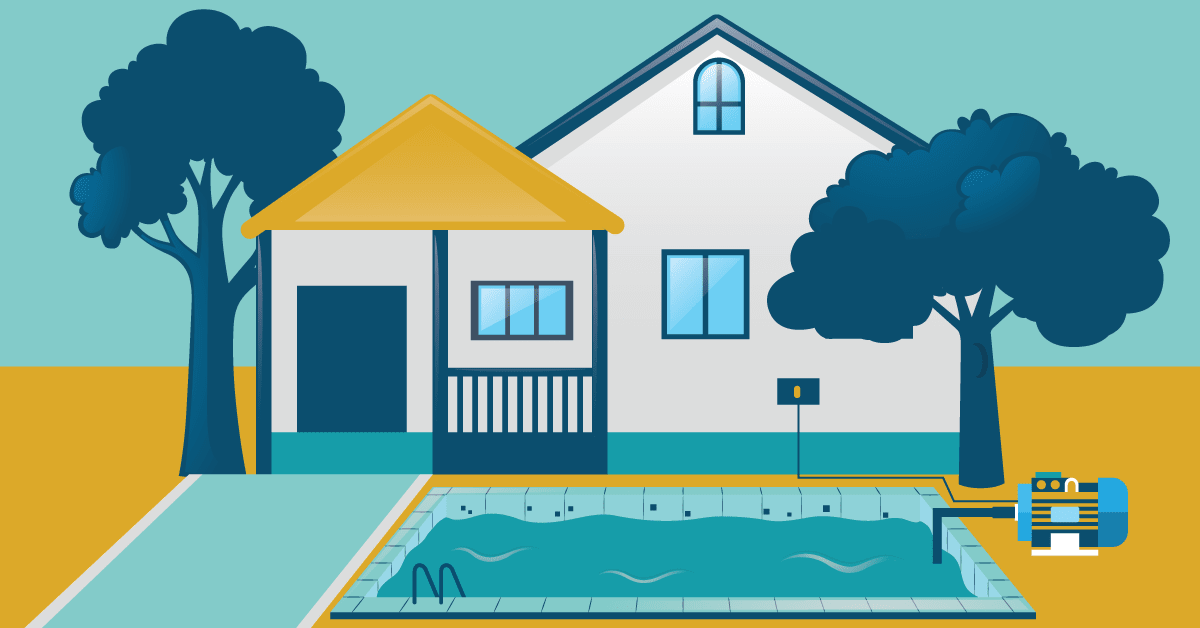The pool pump is the most important part of a pool system. It circulates the pool water so that it does not remain still; stagnant water is a problem because it allows pool algae to accumulate. In addition to that, pumps also help with the mixing of pool cleaning chemicals.
What it mainly does is ensure that nasty gunk, resulting from decaying bugs, leaves, hair, and dead skin, does not make your clear, blue water murky and disgusting.
If you want to have a good time in the water, without worrying if the quality water is reliable and healthy, you need to know how to take care of your swimming pool pump.
Here is an easy-to-follow guide on how to prime a pool pump!
How Do Pool Pumps Work?
Pool pumps have a motor that ensures that the water keeps moving through the pool filtration system, while it’s on. This allows the filter to do its magic and clean the pool. The pump is supposed to be completely filled with water and cannot be run while dry. Therefore, it goes without saying that pool pumps are crucial for the proper functioning of the pool.
Can My Pool Pump Get Damaged?
Your pool pump will get damaged if you leave it on while it’s dry. The pump is made in such a way that it must be filled with water to operate. Therefore, not only will a dry pump not operate properly, it might even burn up if dry; and it goes without saying you will have to dish out a lot of money to replace it.
If the pump is run without water, it will overheat and damage the pump itself along with the pump lid, basket, plumbing. It could also affect the plate, seal, and bearings. Learning how to prime a pool pump correctly is important for the longevity and health of your pump.
What is Pool Pump Priming?
At times, the pool pump gets filled with air. This usually happens when the pool is not used for a long time. As a result, air pockets get into the pump and need to be released. If left unattended, this trapped air causes your pump to burn and malfunction when it is on. The process of getting rid of this trapped air is called pool pump priming.
Is Priming Even Important?
Well, if you do not want to waste hundreds of dollars, the answer is yes. A pump is not something that should be replaced regularly. If it runs while there is air trapped inside, it will malfunction. Priming should not only be done when you first open your pool for the season, but rather should be considered a routine pool maintenance function.
Steps to Prime Your Pool Pump

- Turn the pump’s motor off. This is to ensure you do not get electrocuted.
- Find the multi-port valve on the pump. Switch it so that water goes through only the pump and not the filter, this is called “re-circulate.” If your valve is not labeled, then check the pump’s user manual for instructions.
- Next, wash the pump and the pump basket. The basket should be right under the cover. Make sure any debris or dirt is washed away by rinsing it with a hose.
- Use the diverter valve to let out air from the pump. It is usually at the top of the filter and looks like a round knob. Twist it counterclockwise until the gauge reads 0.
- Use a garden hose to fill the pump basket with water. The water should reach the top of the pump. Continue pouring for at least 2 minutes to ensure the pump has no trapped air.
- Keep the air relief valve open and turn the pump back on. Notice if the water is flowing through it. In the beginning, you may notice a few bubbles, but the water should flow smoothly after a while. If the water is flowing freely, then you have successfully primed the pump.
- After the pump has been running smoothly for a while, turn the air valve clockwise. Do this until it is tight. Then, change the setting of the multiport valve back to “filter.”
- The Hayward Super Pump Single-Speed 1.5 Pool Pump sets the industry standard for efficiency and dependability and is part of the world’s best-selling medium-head pump family
- Heavy-duty, high-performance motor and airflow ventilation provide quieter, cooler, more efficient operation
- Extra-large debris basket provides added leaf-holding capacity for less frequent maintenance
Facing Problems Priming Your Pool? Troubleshoot It
If it has been a while since the pool pump was used, you may face issues priming it. So if it still doesn’t work after trying the above steps a few times, you may have to change tactics. Here are a few suggestions for you to try out:
Add More Water
If your swimming pool pump is not pulling water, it could just be that your pump was not full enough to create enough suction system for it to work. Turn the machine off, take off the pump lid and use a garden hose to add more water. Low water level is the most common cause of pool pumps not working properly.
Add Water Through a Skimmer
You can also run water through the pool skimmer. Skimmers are near the edges of the inside of your pool and work by sucking in water from the surface of the pool and collect debris and regulate water levels. This would help because sometimes air bubbles get trapped further ahead in the swimming pool system.
Adding water from a different direction will help release built-up pressure that could be the cause of your pump not being able to pull air.
Tighten the Valves and Fittings
If your pool pump is still not priming, ensure that all the valves are in the right setting. The fittings should be closed tightly. Leaving them loose could let air escape, which would not let the pump work properly. Check all clamps and valves in case air is coming out from them.
Make Sure Your O-Rings Are Intact
O-rings are used between grooves to compress the parts. They keep water from escaping the system and air from getting into it. Worn out or damaged O-rings cause many issues in pool maintenance. Check all places where O-rings are attached to your pool system.
If they have any tears, replace them immediately. If they are quite worn out or have dry rot, again replace them as soon as you can.
Check for Leaks
If you keep filling it with water and have no luck, a leak may be letting water out. First, check the pump basket and the pump itself for any holes or damage. If the leak is not very big, you can also use a pool putty or a silicone sealant to cover them.
Apply a generous amount of the product onto the damaged area while the pump is running. Then leave the pump running for about a day, so that the putty or sealant harden and get firm. However, a leak cannot be fixed at times, and you may need to purchase a new pool pump.
Call in Professional Help
If your pool pump is still not filling with water, call a professional. This will cost you some money but not as much as buying a new pump. They have experience and will be able to understand the situation better. Tell the professional what issues you are facing and what you have already tried to fix them.
How to Prime a Pool Pump: FAQs
How Do I Restore the Prime on My Pool Pump?
Follow the step-by-step guide provided above under “steps to prime the pool pump” to fix your pump system.
How to Prime a Pool Pump With a Sand Filter?
To manually prime your sand filter pool pump, the steps are the same as the usual method. Follow the previous steps listed above.
My Pool Pump Won’t Prime; What Should I Do?
If your pool pump won’t prime, you will need to troubleshoot the issue. Follow the tips listed above and check all the parts of your pool system.
How Do You Get the Air Out of an Above-Ground Pool Pump?
Above ground pool pumps are the ones usually used; the process for priming them is given above in the step-by-step guide.
Key Takeaways
This guide on priming pool pumps should be all you need to help you address your swimming pool maintenance issues. While it goes without saying that you will have to maintain your pool equipment when you open the pool for the season, it is also important to practice pool maintenance regularly.
The key pointer would be to keep an eye on the pool’s water level and make sure your pump has a consistent flow. Finally, follow this guide, and you will be able to fix anything that could hinder water flow.

For over 15 years, Sean Moore has been sharing his love and enthusiasm for swimming pools and hot tubs with everyone he knows. His goal is to help everyday people DIY their maintenance to save money by teaching how to properly take care of your equipment, safely and correctly balance chemicals, and extend the life of your water oasis.
Pricing on this page was last updated on 2024-04-27



